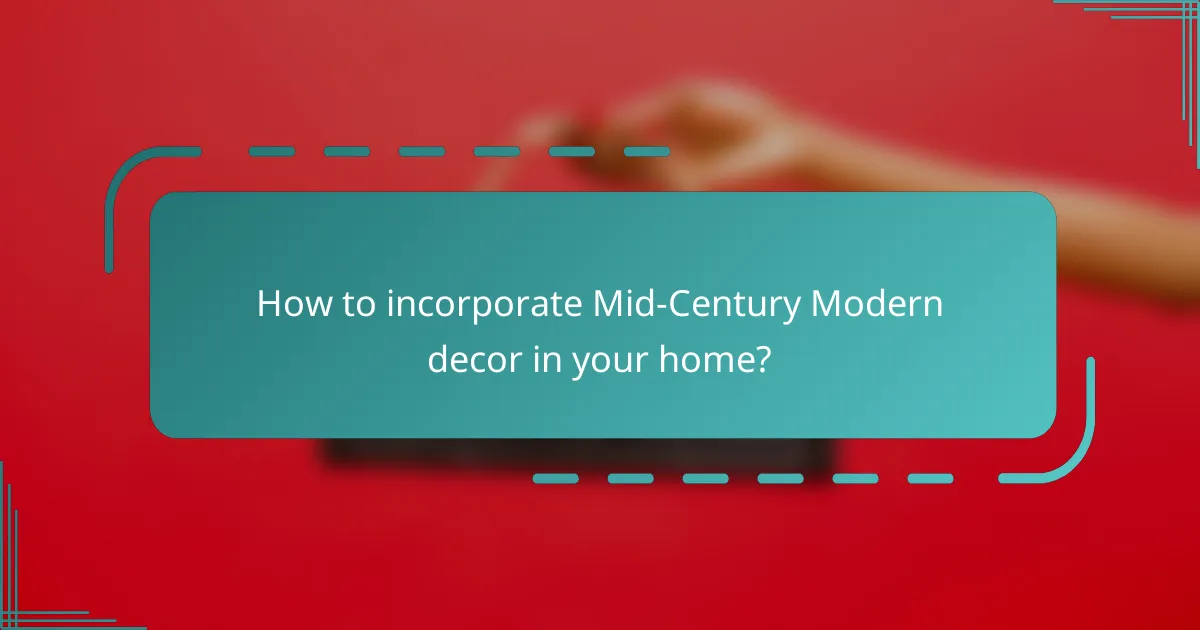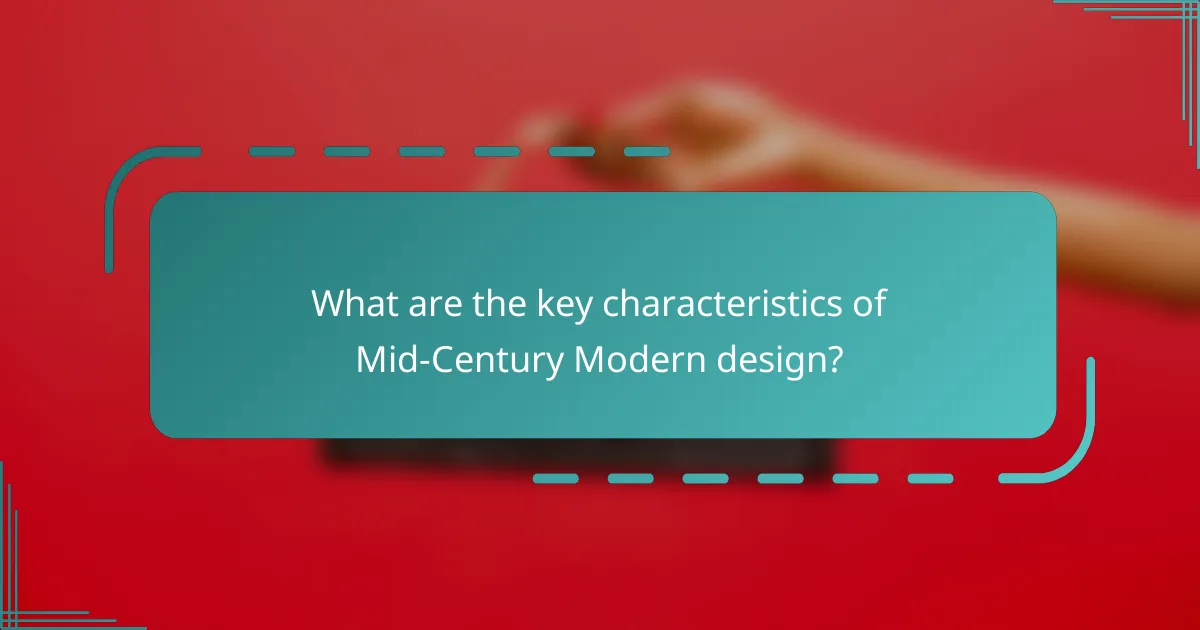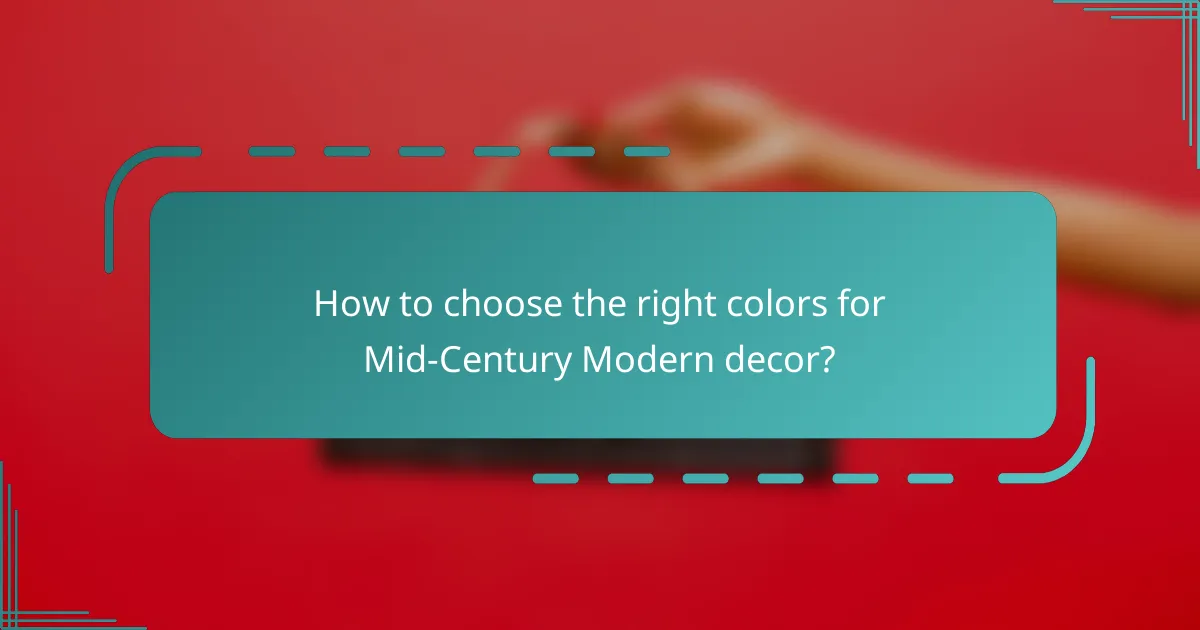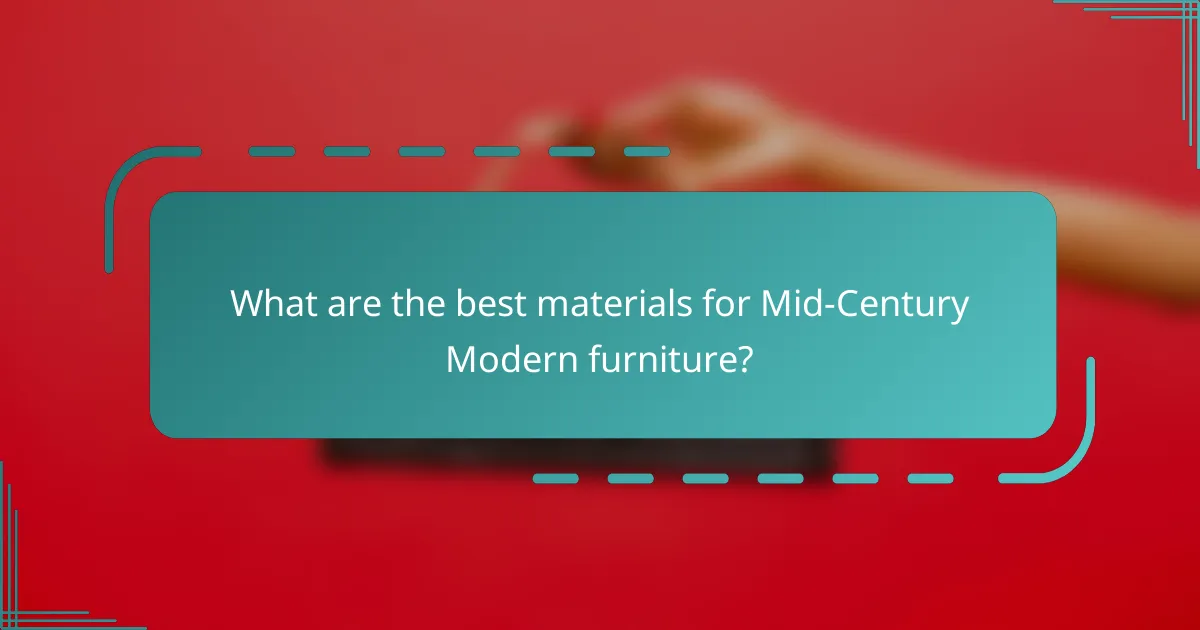Mid-Century Modern decor is a celebration of simplicity and functionality, characterized by clean lines and organic forms that seamlessly blend with nature. By incorporating iconic furniture and bold colors, you can create a cohesive look that reflects this distinctive style. Whether you choose vintage finds or contemporary pieces, the essence of Mid-Century Modern design lies in its practical yet aesthetically pleasing approach.

How to incorporate Mid-Century Modern decor in your home?
Incorporating Mid-Century Modern decor into your home involves selecting key elements that reflect its distinctive style, including iconic furniture, organic shapes, and bold colors. Focus on functional design and a mix of vintage and contemporary pieces to create a cohesive look.
Use iconic furniture pieces like Eames chairs
Iconic furniture pieces, such as Eames chairs, are essential for achieving a Mid-Century Modern aesthetic. These chairs are known for their sleek lines, ergonomic design, and timeless appeal. Consider investing in authentic pieces or high-quality replicas to ensure durability and style.
When selecting furniture, aim for items that combine form and function. Look for pieces with wooden legs, molded plastic, or upholstered options in vibrant colors to enhance your space. Pair these chairs with minimalist tables to maintain a balanced look.
Choose organic shapes in lighting fixtures
Lighting fixtures with organic shapes can significantly enhance the Mid-Century Modern vibe in your home. Opt for designs that feature curves and asymmetrical forms, such as pendant lights or floor lamps with sculptural qualities. These elements add visual interest and a sense of flow to your decor.
Materials like brass, glass, and wood are commonly used in Mid-Century lighting. Consider fixtures that incorporate these materials to create a warm and inviting atmosphere. Remember to choose lighting that complements your furniture and overall color scheme for a harmonious look.
Integrate bold colors and patterns
Bold colors and patterns are hallmarks of Mid-Century Modern decor. Incorporate vibrant hues like mustard yellow, teal, or burnt orange through textiles, wall art, or accent pieces. These colors can energize your space and create a focal point.
When using patterns, consider geometric designs or abstract motifs that reflect the era’s artistic influences. Throw pillows, rugs, and curtains are great ways to introduce these elements without overwhelming the room. Aim for a balanced mix of colors and patterns to maintain a cohesive aesthetic.
Mix vintage and contemporary elements
Mixing vintage and contemporary elements is key to achieving a well-rounded Mid-Century Modern decor. Combine authentic vintage pieces with modern designs to create an eclectic yet cohesive environment. This approach allows you to showcase your personal style while honoring the era’s aesthetic.
When blending styles, ensure that the colors, materials, and shapes complement each other. For instance, pair a vintage coffee table with contemporary seating to create visual contrast. This mix not only adds character but also keeps your space feeling fresh and inviting.

What are the key characteristics of Mid-Century Modern design?
Mid-Century Modern design is characterized by its emphasis on simplicity, functionality, and a seamless integration with nature. This style features clean lines, organic forms, and a focus on practical use, making it both aesthetically pleasing and highly functional.
Emphasis on functional design
Functional design in Mid-Century Modern decor prioritizes usability without sacrificing style. Furniture and decor items are crafted to serve a purpose, often incorporating innovative materials and techniques that enhance their practicality. For instance, multi-functional furniture pieces, such as a sofa bed or a coffee table with storage, exemplify this approach.
When selecting items, consider how each piece will fit into your daily life. Look for designs that offer versatility, such as modular seating or extendable dining tables, which can adapt to varying needs and spaces.
Use of organic and geometric forms
Mid-Century Modern design skillfully combines organic and geometric forms to create a harmonious aesthetic. Organic shapes often mimic natural elements, while geometric forms provide structure and balance. This blend results in a visually appealing environment that feels both inviting and grounded.
In practice, you might see rounded chairs alongside angular tables, creating a dynamic interplay of shapes. When decorating, aim for a mix of these forms to achieve a well-rounded look that reflects the essence of this design style.
Minimal ornamentation
Minimal ornamentation is a hallmark of Mid-Century Modern design, which favors clean surfaces and uncluttered spaces. This approach allows the beauty of the materials and the craftsmanship to shine through without distraction. Decorative elements are often subtle and thoughtfully placed, enhancing rather than overwhelming the space.
To embrace this principle, focus on a few key pieces that stand out, such as a striking piece of art or a unique light fixture. Avoid overcrowding surfaces with knick-knacks; instead, curate a selection of items that reflect your personal style while maintaining a sense of openness and clarity in the design.

Where to find authentic Mid-Century Modern decor in the UK?
To find authentic Mid-Century Modern decor in the UK, explore specialty vintage shops, online marketplaces, and local auctions. These avenues offer a range of options from unique pieces to curated collections that reflect the iconic style of this design era.
Specialty vintage shops in London
London boasts a variety of specialty vintage shops that focus on Mid-Century Modern decor. Notable areas include Shoreditch and Notting Hill, where you can find shops like Midcentury Modern and Retro Living. These stores often feature carefully selected items, including furniture, lighting, and accessories.
When visiting, check for authenticity certificates and be prepared to negotiate prices. Items can range from a few hundred to several thousand pounds, depending on rarity and condition.
Online marketplaces like 1stdibs
Online marketplaces such as 1stdibs offer a vast selection of Mid-Century Modern decor from various sellers. This platform allows you to browse items from around the world, including furniture, art, and decorative objects. Prices can vary widely, starting from a few hundred pounds to tens of thousands for rare pieces.
When shopping online, always review seller ratings and return policies. Look for detailed descriptions and high-quality images to ensure the item meets your expectations.
Local auctions and estate sales
Local auctions and estate sales can be treasure troves for Mid-Century Modern decor. Keep an eye on auction houses in your area, such as Bonhams or Christie’s, which frequently feature themed sales. Estate sales often include personal collections, providing unique finds at potentially lower prices.
To participate, research upcoming events and register in advance. Set a budget and stick to it, as bidding can quickly escalate. Inspect items closely before bidding to assess their condition and authenticity.

What are the benefits of Mid-Century Modern decor?
Mid-Century Modern decor offers a blend of aesthetic beauty and functional design, making it a popular choice for many homeowners. Its focus on clean lines, organic forms, and retro shapes creates a timeless appeal that enhances various living spaces.
Timeless aesthetic appeal
The aesthetic of Mid-Century Modern decor is characterized by simplicity and elegance. Its iconic designs, featuring smooth curves and geometric shapes, remain visually striking decades after their inception. This style often incorporates natural materials like wood and leather, adding warmth and texture to interiors.
Many pieces from this era, such as Eames chairs or Noguchi tables, are considered artful statements that can elevate the overall look of a room. Their enduring charm makes them suitable for both contemporary and traditional settings.
Versatile for various interior styles
Mid-Century Modern decor seamlessly integrates with a wide range of interior styles, from minimalist to eclectic. Its neutral color palettes and functional designs allow it to complement other furnishings without overwhelming the space.
For example, pairing a classic teak sideboard with modern art or mixing vintage chairs with contemporary tables can create a harmonious blend of old and new. This versatility makes it easier to adapt the decor to personal tastes and changing trends.
High resale value for vintage pieces
Investing in Mid-Century Modern decor can yield high resale value, particularly for authentic vintage items. Many collectors and enthusiasts seek out original pieces, driving demand and prices higher in the market.
When considering resale, focus on well-known designers and brands, as these often retain their value better. Items in good condition or with unique features can command premium prices, making them worthwhile investments for decor enthusiasts.

How to choose the right colors for Mid-Century Modern decor?
Choosing the right colors for Mid-Century Modern decor involves selecting a palette that reflects the style’s emphasis on simplicity and organic forms. Focus on earthy tones and pastels as a base, while incorporating vibrant accent colors to create visual interest and depth.
Opt for earthy tones and pastels
Earthy tones like olive green, mustard yellow, and terracotta are foundational to Mid-Century Modern decor. These colors evoke a connection to nature and complement the organic shapes typical of this style. Pastels such as mint green, soft pink, and light blue can also enhance the serene atmosphere.
When using earthy tones and pastels, consider balancing them with neutral shades like white, beige, or gray to maintain a cohesive look. A good rule of thumb is to use these softer colors for larger surfaces, such as walls and furniture, while reserving bolder shades for smaller accents.
Incorporate vibrant accent colors
Vibrant accent colors like teal, orange, and deep red can add energy and personality to Mid-Century Modern spaces. These hues work well in accessories such as cushions, artwork, and decorative items, creating focal points that draw the eye. When choosing accents, aim for a few standout pieces rather than overwhelming the space.
To effectively incorporate vibrant colors, consider the 60-30-10 rule: 60% of the room should be a dominant color, 30% a secondary color, and 10% an accent color. This approach helps maintain balance while allowing for bold expression in your decor.

What are the best materials for Mid-Century Modern furniture?
The best materials for Mid-Century Modern furniture include wood, metal, and upholstery fabrics that emphasize simplicity and functionality. These materials not only reflect the aesthetic of the era but also provide durability and comfort.
Wood
Wood is a fundamental material in Mid-Century Modern design, often featuring rich tones like teak, walnut, and oak. These woods are prized for their grain patterns and strength, making them ideal for furniture that lasts. When selecting wooden pieces, look for clean lines and minimal ornamentation to maintain the style’s characteristic simplicity.
Metal
Metal elements, such as steel and aluminum, are commonly used in Mid-Century Modern furniture for their sleek, industrial appeal. These materials can be found in legs, frames, and accents, providing a contrast to the warmth of wood. Opt for finishes like chrome or brushed metal to enhance the retro look while ensuring durability.
Upholstery Fabrics
Upholstery fabrics in Mid-Century Modern furniture often include bold patterns and vibrant colors, reflecting the playful spirit of the era. Common choices are wool, cotton, and synthetic blends that offer both comfort and resilience. When selecting upholstery, consider fabrics that are easy to clean and maintain, as this will prolong the life of your furniture.
